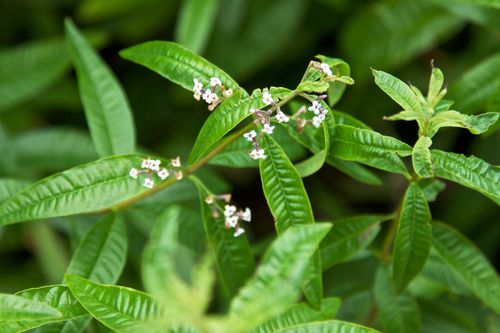 Overview: Lemon verbena is a deciduous, woody shrub which is native to south America. The leaves have a strong lemon scent, which makes this plant a great substitute for fresh lemon.
Overview: Lemon verbena is a deciduous, woody shrub which is native to south America. The leaves have a strong lemon scent, which makes this plant a great substitute for fresh lemon.
Latin Name: Aloysia triphylla.
Common Name: Lemon verbena.
Alternate Names: Known as the lemon plant in Victorian times.
Zones: Hardy to USDA Zones 9-11.
Sun: Full sun.
Soil: Well drained soil.
Mature Size: When grown outdoors, in the ground, lemon verbena can grow up to 10 feet high and ten feet wide. Leaves reach up to 4 inches long. Container grown plants will be significantly smaller. Produces small, pale lavender flowers in late summer.
Starting New Plants: Lemon verbena can be started from cuttings taken in the late summer. Lemon verbena can also be started from seeds, however; homegrown plants rarely produce seeds. If you can find lemon verbena seeds from a gardening catalog, you may want to try starting plants from seed.
Parts Used: Both the fresh and dried leaves are used for a variety of culinary, aroma therapeutic and medicinal uses. The dried leaves will retain their strong lemon fragrance for up to 3 years.
Culinary Uses: Both the fresh and the dried leaves can be used in a variety of culinary creations. The leaves can be a bit tough, so be sure to choose small, tender leaves and leaf tips. If using fresh leaves, finely chop them before adding them to recipes.
Infuse the dried leaves into a calming, relaxing tea. The finely chopped leaves can be added to baked goods, poultry stuffing, fruit salads, dressings, sauces and even homemade ice cream.
Aromatherapy Uses: The essential oil can be used to scent soaps, candles, bath oils and perfumes. Use caution when working with the undiluted essential oil, as it can cause photosensitivity in susceptible individuals. However; when diluted with other ingredients, as when making a lotion, this shouldn’t be a problem. The dried leaves make a wonderful addition to potpourri blends and sachets.
Medicinal Uses: Lemon verbena helps soothe bronchial and nasal congestion. It is a sedative and calming herb which can be used to help quiet a nervous disposition. Lemon verbena has also been used to bring relief from various digestive problems including indigestion, gas and nausea.
Growing Tips: Pinch out the leaf tips in order to encourage a bushy plant. New growth doesn’t appear until late spring or early summer, so don’t think the plant has died if new growth isn’t showing at the first sign of spring. Lemon verbena is a heavy feeder and needs regular applications of fish emulsion or liquid seaweed fertilizer during the summer.
Unless you live in the subtropics or tropics, lemon verbena won’t do well grown directly in the garden. However; lemon verbena does quite well when grown in containers. The containers can be placed outdoors during the late spring through summer, and brought indoors once the temperature falls below 20 ° Fahrenheit.
Indoor plants may attract spider mites. Use a plant mister to gently wash off the mites from the leaves. Most of the leaves may fall off in the winter, as lemon verbena is a deciduous plant. Prune back the plant to 10-12 inches and reduce the amount of water it is given during the winter. Move the container back outside in the late spring, once the temperature has warmed up.









+ There are no comments
Add yours